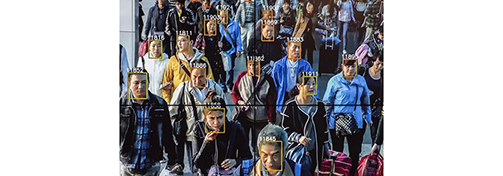The proprioceptive sense informs us about the position of our own limbs in relation to one another and to the space around us. Its sensations come from the muscles and tendons and are not localized. The proprioceptive and tactile sensations combine to constitute the haptic. Proprioceptive feedback is an important developmental component in the sense of agency.
virtual
Surveillance

Computer profiles generate objects for surveillance - they instruct or train the observer in what to watch and how to watch for it. Police, psychiatrists, educators, physicians, to name just a few groups, increasingly use profile technology for early or pre-identification of various traits within preselected populations - if you match enough elements of the profile, you could become atarget, even before any trait has manifested itself. To prepare the observer, to train the observer to see, and in the last instance, to be the observer's eyes, this is the imaginary of the simulation of surveillance.
Read Morevirtual
"Reality is that which is, 'virtuality' is that which seems to be." (Ted Nelson)
Traditionally, for something to be virtual meant that it possessed the powers or capabilities of something else. In the late 1950's, scientists developed what they called "virtual computers" -- machines quick enough to handle several users sequentially while giving each user the impression of being the only one using the computer.
In this same sense, a propagating information structure, such as a "glider" in the "game of life" (see cellular automata) is a virtual machine. For Christopher Langton, behaviors themselves can constitute the fundamental parts of non-linear systems, virtual parts, which depend on non-linear interections between physical parts for their very existence.
The Danish physicist Benny Lautrup distinguishes between "real" computer organisms and "virtual" ones. The virtual computer organisms are those designed to be completely dependent on a specific habitat inside the machine -- in games, in cellular automata, or in virtual environments such as the Tierra simulator. The environments for real computer organisms, known as computer viruses, are real computers, real hardware, mainframes, or networks.
Or is the virtual that which could be ? ......
...."Could be !"
If techno-usage stresses the dematerialized, computational capacities of the virtual, the philosophical tradition that passes through Bergson and Deleuze stresses the latent potentialities of the virtual.
Etymologically, virtual means full of virtue, virtue being taken here as the capacity to act.
Virtue / virtual / virtuous (see virtual reality ) Does the etymology of virtue from vir suggest anything?
Read Morewriting
Is writing merely a way of recording language by visible marks, or does it have its own linguistic function? Edmund Husserl describes writing as virtual communication. It makes communications possible without immediate or even mediate personal address. By means of writing, the socialization of humanity is elevated to a new stage.
From Assyrian time on, the bulk of writing is in administrative and economic documents, mainly in the form of lists. In referring to the "scriptural economy" Michel De Certeau (The Practice of Everyday Life) points to writing as a "triumphal conquista of the economy, that has, since the beginning of the 'modern age' given itself the name of writing." (p. 131) For de Certeau, the installation of the scriptural apparatus is the triumph of a modern discipline." In modern western culture the practice of writing is a myth which gives symbolic articulation to the Occidental ambition to compose its history, and thus to compose history itself." Here, as elsewhere, de Certeau seeks to find archaic processes of resistance within the discipline itself, in this case, forms of orality, and to rehabilitate reading as a nomadic poaching.
De Certeau describes writing as "the concrete activity that consists in constructing, on its own, blank space (un espace propre ) --the page-- a text that has the power over the exteriority from which it has been isolated." (p. 134)
Read More